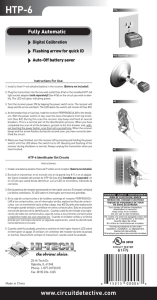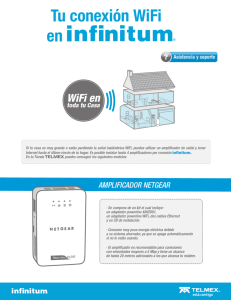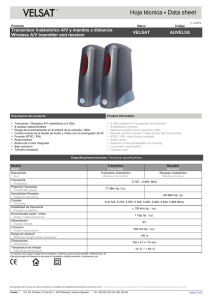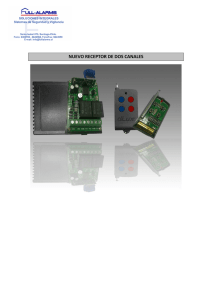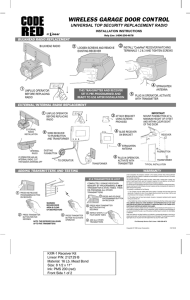Hi-Tech HTP7P rev. 5 - HI
Anuncio
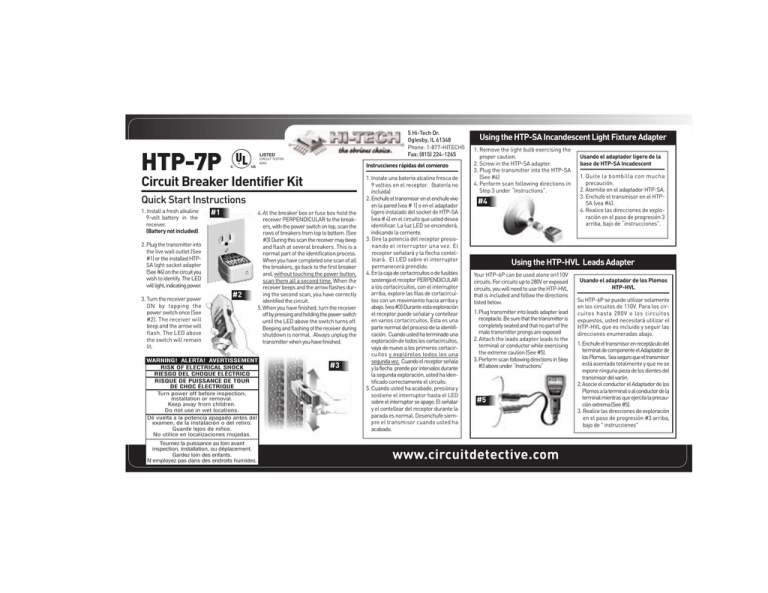
HTP-7P 5 Hi-Tech Dr. Oglesby, IL 61348 Phone: 1-877-HITECH5 Fax: (815) 224-1265 LISTED CIRCUIT TESTER 8ZX5 C Instrucciones rápidas del comienzo US Circuit Breaker Identifier Kit Quick Start Instructions 1. Install a fresh alkaline 9-volt battery in the receiver. (Battery not included). #1 2. Plug the transmitter into the live wall outlet (See #1) or the installed HTPSA light socket adapter (See #4) on the circuit you wish to identify. The LED will light, indicating power. 3. Turn the receiver power ON by tapping the power switch once (See #2). The receiver will beep and the arrow will flash. The LED above the switch will remain lit. #2 4. At the breaker box or fuse box hold the receiver PERPENDICULAR to the breakers, with the power switch on top, scan the rows of breakers from top to bottom. (See #3) During this scan the receiver may beep and flash at several breakers. This is a normal part of the identification process. When you have completed one scan of all the breakers, go back to the first breaker and, without touching the power button, scan them all a second time. When the receiver beeps and the arrow flashes during the second scan, you have correctly identified the circuit. 5. When you have finished, turn the receiver off by pressing and holding the power switch until the LED above the switch turns off. Beeping and flashing of the receiver during shutdown is normal. Always unplug the transmitter when you have finished. WARNING! ALERTA! AVERTISSEMENT RISK OF ELECTRICAL SHOCK RIESGO DEL CHOQUE ELÉCTRICO RISQUE DE PUISSANCE DE TOUR DE CHOC ÉLECTRIQUE Turn power off before inspection, installation or removal. Keep away from children. Do not use in wet locations. Dé vuelta a la potencia apagado antes del examen, de la instalación o del retiro. Guarde lejos de niños. No utilice en localizaciones mojadas. Tournez la puissance au loin avant inspection, installation, ou déplacement. Gardez loin des enfants. N'employez pas dans des endroits humides. #3 1. Instale una batería alcalino fresca de 9 voltios en el receptor. (batería no incluida) 2. Enchufe el transmisor en el enchufe vivo en la pared (vea # 1) o en el adaptador ligero instalado del socket de HTP-SA (vea # 4) en el circuito que usted desea identificar. La luz LED se encenderá, indicando la corriente. 3. Gire la potencia del receptor presionando el interruptor una vez. El receptor señalará y la flecha contelleará. El LED sobre el interruptor permanecerá prendido. 4. En la caja de cortacircuítos o de fusibles sostenga el receptor PERPENDICULAR a los cortacircuítos, con el interruptor arriba, explore las filas de cortacircuítos con un movimiento hacia arriba y abajo. (vea #3) Durante esta exploración el receptor puede señalar y contellear en varios cortacircuítos. Ésta es una parte normal del proceso de la identificación. Cuando usted ha terminado una exploración de todos los cortacircuítos, vaya de nuevo a los primeros cortacircuítos y explórelos todos los una segunda vez. Cuando el receptor señala y la flecha prende por intervalos durante la segunda exploración, usted ha identificado correctamente el circuito. 5. Cuando usted ha acabado, presiona y sostiene el interruptor hasta el LED sobre el interruptor se apage. El señalar y el contellear del receptor durante la parada es normal. Desenchufe siempre el transmisor cuando usted ha acabado. Using the HTP-SA Incandescent Light Fixture Adapter 1. Remove the light bulb exercising the proper caution. 2. Screw in the HTP-SA adapter. 3. Plug the transmitter into the HTP-SA (See #4) 4. Perform scan following directions in Step 3 under “Instructions”. #4 Usando el adaptador ligero de la base de HTP-SA Incadescent 1. Quite la bombilla con mucha precaución. 2. Atornille en el adaptador HTP-SA. 3. Enchufe el transmisor en el HTPSA (vea #4). 4. Realice las direcciones de exploración en el paso de progresión 3 arriba, bajo de “instrucciones”. Using the HTP-HVL Leads Adapter Your HTP-6P can be used alone on110V circuits. For circuits up to 280V or exposed circuits, you will need to use the HTP-HVL that is included and follow the directions listed below. 1. Plug transmitter into leads adapter lead receptacle. Be sure that the transmitter is completely seated and that no part of the male transmitter prongs are exposed 2. Attach the leads adapter leads to the terminal or conductor while exercising the extreme caution (See #5). 3. Perform scan following directions in Step #3 above under “Instructions” #5 www.circuitdetective.com Usando el adaptador de los Plomos HTP-HVL Su HTP-6P se puede utilizar solamente en los circuitos de 110V. Para los circuitos hasta 280V o los circuitos expuestos, usted necesitará utilizar el HTP-HVL que es incluido y seguir las direcciones enumeradas abajo. 1. Enchufe el transmisor en receptáculo del terminal de componente el Adaptador de los Plomos. Sea seguro que el transmisor está asentado totalmente y que no se expone ninguna pieza de los dientes del transmisor del varón. 2. Asocie el conductor el Adaptador de los Plomos a la terminal o al conductor de la terminal mientras que ejercita la precaución extrema (See #5). 3. Realice las direcciones de exploración en el paso de progresión #3 arriba, bajo de " instrucciones"
